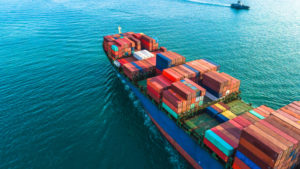Forget the 7.5% headline inflation. That doesn’t do justice to what you and I are paying in our own lives. In my conversations with you, for example, you’re telling me that the cost for shipping containers is up 300%, to be kind, and as much as 500% when all costs are included—not 7.5%. And yet the Biden admin talks to you like it’s transitory. It’s not transitory when you keep paying higher prices for months on end. Costas Paris reports in The Wall Street Journal:
Container ship operators and big importers like IKEA and Walmart Inc. will soon negotiate freight rates that could affect the prices consumers pay for everything from jeans to cars.
Yearlong freight contracts, which contribute up to three-quarters of annual revenue for ship operators, will largely be settled at the TPM conference in Long Beach, Calif., next week. The average price to move a 40-foot box from China to the U.S. West Coast is likely to be between $7,000 and $8,000, a record high for annual freight pacts and higher than last year’s average of around $5,500, according to a half-dozen executives of carriers and importers involved in the talks.
After two years of supply-chain disruptions and transportation delays through the Covid-19 pandemic, importers are putting a premium on reliability and predictability of services, with some seeking longer-term freight contracts, analysts say. More than a quarter of all shipping containers entering the U.S. are cargo for large importers such as Walmart and Amazon.com Inc., among others, according to ship operators and freight forwarders.
“We are now increasingly seeing importers sign up to yearly contracts early as well as to contracts of a longer duration,” said Lars Jensen, chief executive officer of Denmark-based advisory firm Vespucci Maritime. “It is about managing risk in an environment where the uncertainty about the stability of the supply chain in 2022 continues to be very high.”
Representatives from several carriers and cargo owners declined to comment on the freight talks. A range of companies in recent months have said higher transportation costs or efforts to get around supply-chain issues have eaten into their profit margins, with some projecting expenses to remain at elevated levels this year.
“The biggest challenge we have on the gross margin side right now is the freight costs,” said David Bergman, Under Armour Inc.’s finance chief, on an earnings call earlier this month, adding that freight rates will likely “take a little bit longer to subside.”
Hasbro Inc., the American toy and entertainment multinational, said earlier this month that scheduled price increases in the second quarter will offset higher freight costs, but the supply-chain environment will remain challenging this year.
“We’ve never had such market dynamics, with the liners holding all the cards,” said Patrik Berglund, CEO of Norway-based transportation data and procurement specialist Xeneta. “The top five operators control three-quarters of all container capacity. That’s a lot of pricing power to very few players.”
Earnings for container shippers took off during the pandemic, as demand for manufactured goods like appliances, cars and home-improvement materials soared, with not enough ships to move them. At the same time, labor shortages from Covid-19 outbreaks at ports across the world and not enough truck, rail and warehousing capacity extended delivery times.
Action Line: Of course, there is one sure way companies can avoid high shipping costs. That is, make their products in America. Visit Your Survival Guy daily to stay ahead of tomorrow’s headlines, and stick with me to stay in the know.
E.J. Smith - Your Survival Guy
Latest posts by E.J. Smith - Your Survival Guy (see all)
- Your Survival Guy Breaks Down Boxes, Do You? - April 25, 2024
- Oracle’s Vision for the Future—Larry Ellison Keynote - April 25, 2024
- Investing Is Math - April 25, 2024
- Breaking: New Rules on Trillions in IRAs and 401(k)s - April 24, 2024
- When You’re in Control, You Have Opportunities - April 24, 2024
















